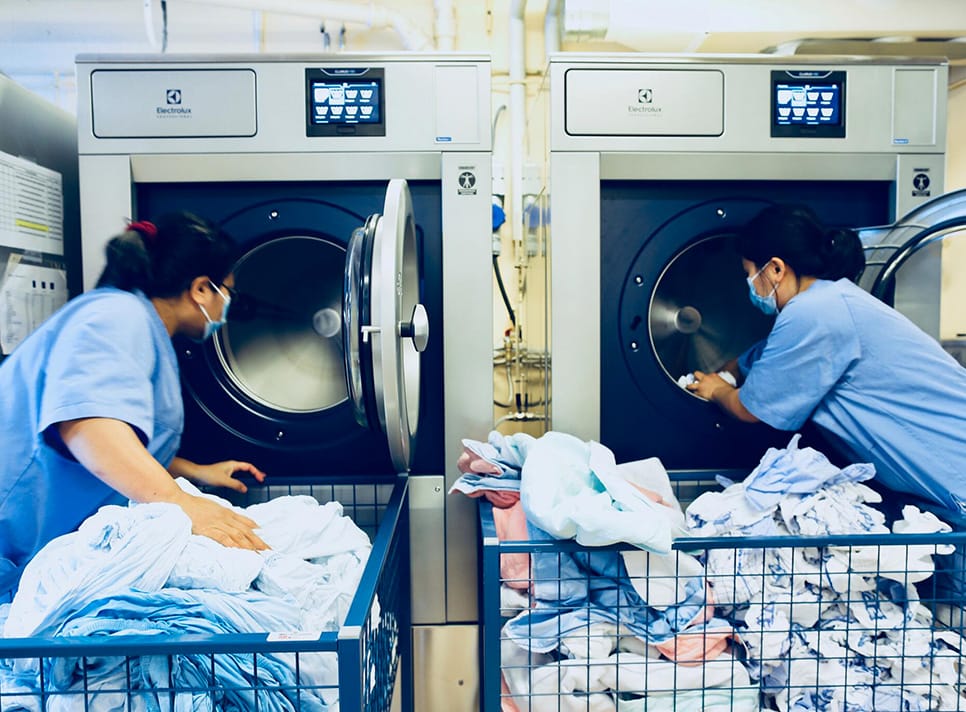The step-by-step guide to reducing the risk of infection in the healthcare sector
Even during “precedented” times, healthcare-associated infections (HCAIs) affect billions of patients globally every year.
More than four million patients are estimated to acquire an HCAI in the EU each year, and in 2020, acute care hospitals in the US saw a marked increase in HCAIs, the first rise following five years of falling figures.
In the wake of a global pandemic, it has never been more critical for everyone across the healthcare sector to take concerted steps to minimize the spread of infection and keep staff and patients safe.
Soiled linen is a major vehicle for potentially harmful bacteria. Total thermal disinfection during commercial washing can minimize the risk to staff and patients. One of the most effective ways to reduce an infection outbreak in any healthcare environment is through implementing an effective Laundry Cycle Management process.
Here are the key steps for an effective Laundry Cycle Management.
1. Pre-wash
Effective infection prevention begins even before items enter the commercial washing machine. These first pre-washing steps are vital to ensuring that healthcare laundry is sorted and washed at the right time and temperature for total thermal disinfection to reduce the risk of an outbreak in your facility.
Pre-sort
Firstly, pre-sort dirty healthcare laundry by textile at the point of collection. Sort cottons, synthetics, delicates, and other fabric types into separate sections of the laundry washing trolley. This ensures that each type of material is ready to be washed at the correct time and temperature, reducing the risk of contamination and damage to the material.
Separate
To avoid contamination of soiled or infected linen to the surrounding environment, it is important to use the proper packaging to separate soiled linen into a designated section of the laundry washing trolley. Establishments should have separate trolleys and areas for clean and dirty linens, with secure plastic bags for materials that could pose a risk.
Sort and check
Finally, check laundry for sharp objects or anything which could damage the material. Place any items used during the cleaning process into an appropriate bag to be transferred to laundry. Then dispose of any gloves, apron or other disposable items, and wash hands thoroughly according to the establishment’s guidelines.
2. Washing, drying and ironing
Electrolux Professional manufactures commercial washing machines designed to ensure maximum hygiene at every step of the process without compromising on costs. Our Line 6000 Barrier Washers are a cost-effective sustainable solution for any healthcare facility, providing impeccable hygiene results and ergonomic designs benefiting patients and staff.
Wash
Having properly sorted the laundry, choose the correct temperature and chemical setting for each fabric type. Keep in mind that overloading or underloading the washer will negatively affect the wash result.
Our Line 6000 washers use a pre-wash function to loosen dirt from heavily soiled fabrics. They also automatically weigh the laundry to ensure the best results with minimum water and energy consumption.
Dry and iron
Once the washing cycle has completed, unload the laundry into a clean, designated trolley and place it into the dryer. Limit as much as possible the number of times the clean laundry is handled. For the best results, avoid overloading and underloading the dryer and ensure the daily maintenance of all appliances. Lastly, the ironing process is a final thermal disinfection. Once again, laundry should be ironed according to textile type to avoid damaging the material. Ensure that both drying and ironing take place as soon as possible after washing to prevent recontamination.
3. Post-laundry
Proper care and attention to the laundry of linen plays an essential role in contamination control in hospitals, care homes and other health facilities worldwide.
Pack
Once correctly washed, dried, and ironed, securely pack clean linen to reduce the risk of contamination from the external environment. Freshly cleaned healthcare laundry should be placed into the designated clean trolley or another transportation device to be returned to the required hospital area.
Transport
Always use designated clean routes when transporting laundry to the required section of the healthcare facility. This helps avoid recontamination and is a key part of establishing a structured laundry cycle process.
Store
Storing clean linen effectively is one of the most important ways to protect it from contamination and damage by microorganisms. Replace any wood shelving with hygienic alternatives such as metal or plastic to reduce the risk of bacteria growth. Also, make sure to use the linen stored for the most prolonged period first to avoid extended storage times.
Final thoughts
Cleaning, sanitization, and decontamination are key across many industries, particularly in hospitals and healthcare facilities where issues can lead to illness and even fatalities. Electrolux Professional has focused closely on enhancing laundry standards, with solutions designed specifically to support hygiene and avoid infections risks, with particular attention given to linen and professional clothing.
The effective use of professional barrier laundry solutions such as Electrolux Professional’s Line 6000, combines complete hygiene assurance and first-class ergonomic designs. Your staff will find them easy to use and you’ll have peace of mind that the highest-quality hygiene procedures and appliances will play an integral role in keeping residents and their families safe from infection.
To properly prevent the spread of infection in healthcare laundry settings, it is important to ensure all healthcare staff are trained to use an organized Laundry Cycle Management process in combination with professional, hygiene-efficient appliances.
Find out more about Electrolux Professional’s barrier washers and best-performance appliances here.
